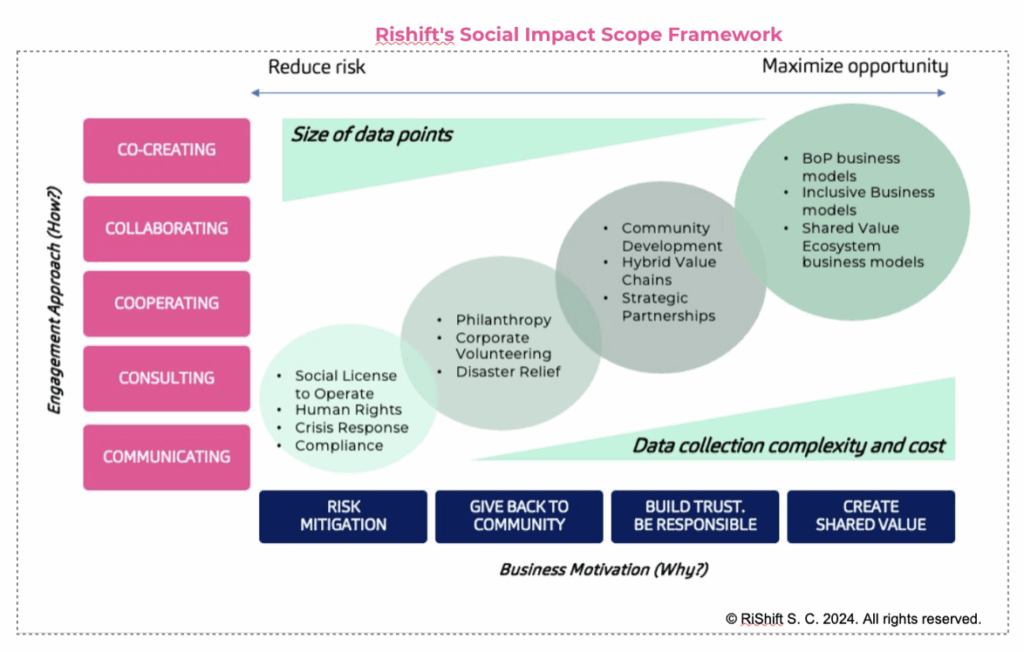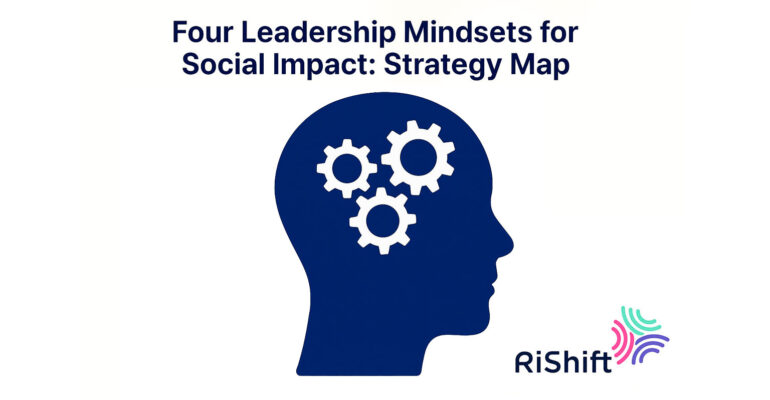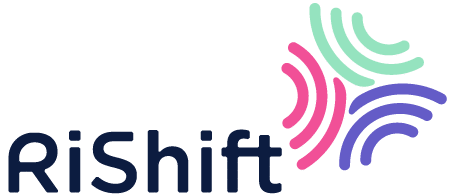Four Leadership Mindsets for Social Impact: Strategy Map
For more than eight decades, executives and scholars have debated whether business has responsibilities beyond profit maximization. Today, that debate is no longer theoretical—investors, regulators, and communities expect companies to articulate and demonstrate their social role. The lesson is clear: companies don’t evolve along a single maturity path. Instead, they operate across a portfolio of approaches—adapting different mindsets depending on geography, sector, or stakeholder pressure. At RiShift, we developed the Social Impact Scope Framework as a practical configuration tool. It helps leaders clarify purpose, align governance and partnerships, and ensure that evidence is robust enough for investor-grade disclosure. The framework makes the trade-offs visible rather than hidden in slogans.

Mindset 1: Risk Mitigation – How to secure the social license to operate
Typical engagement approaches (in the figure): Communicating → Consulting
Business motivation: Risk mitigation (far‑left of the x‑axis)
What it looks like: Compliance, human‑rights due diligence, grievance mechanisms, crisis response, environmental & product safety controls, community consent/acceptance (“social license to operate”).
This mindset is the pragmatic baseline. Without credible risk mitigation—compliance programs, grievance mechanisms, worker safety—other strategies struggle to gain legitimacy.. In practice, that means compliance programs that work, product and environmental safety, worker protections, and human‑rights due diligence with effective grievance and remedy. The emphasis is on proof: clear policies, documented controls, incident records, and corrective actions. Frameworks such as the UN Guiding Principles on Business and Human Rights (UN, 2011) and the OECD Guidelines for Multinational Enterprises (OECD, 2011) articulate these expectations; they also anchor investor‑facing disclosures that increasingly require assurance.
Mindset 2: Give Back to Society
Typical engagement approaches (in the figure): Communicating / Cooperating
Business motivation: Community benefit; license and goodwill (left‑of‑center)
What it looks like: Philanthropy, corporate volunteering, disaster relief, in‑kind support; place‑based programs that leverage core capabilities .
Corporate philanthropy is the most familiar expression of social intent: companies direct surplus resources—funding, skills, in‑kind support—toward public benefit. Properly designed, it aligns with place‑based priorities and leverages core capabilities (for example, logistics for disaster relief or data expertise for education). Measurement here should be proportionate. Tracking outputs—grants, volunteer hours, beneficiaries—often suffices, complemented by a small set of outcomes that reflect intent, such as school completion, employability, or adherence to treatment. Philanthropy can complement strategy when it leverages core capabilities. But clarity is essential: when it is truly strategic, say so; when it is not, avoid overstating its impact.
Mindset 3: Be Responsible- From narrative to accountability
Typical engagement approaches (in the figure): Consulting → Cooperating
Business motivation: Build trust; accountability; manage material risks (center)
What it looks like: Responsible sourcing, supplier human‑rights due diligence, crisis response, community agreements, impact disclosure (ISO 26000, GRI) and financially material risk/opportunity disclosure (IFRS S1/S2).
Responsibility moves inside the operating model. The question shifts from “What do we donate?” to “How do we run the business?”—with attention to responsible sourcing, supplier due diligence, crisis response, community agreements, and impact disclosure. The responsible‑business conversation matured from early theorizing to practical guidance and standards. Bowen (1953) (Bowen, 1953) is frequently cited for framing managerial responsibility in relation to societal values. ISO 26000 (2010) (ISO, 2010) gathered global guidance on social responsibility, while the GRI Standards (GRI, current) supplied a common language for reporting impacts. Most recently, investor‑grade sustainability disclosure has converged through IFRS S1/S2 (ISSB, 2023) (IFRS Foundation/ISSB, 2023), tightening the link between sustainability risks/opportunities and financial reporting. As companies adopt these frameworks, their data footprint expands: more topics, deeper evidence, stronger controls, and—in many cases—assurance‑ready traceability. A sustainability report should be the by-product of disciplined management systems, not the endgame. Reporting credibility flows from robust controls.
Mindset 4 — Opportunity & Prosperity (Shared Value ➝ Stakeholder Ecosystems)
Typical engagement approaches (in the figure): Collaborating → Co‑creating (firm & ecosystem)
Business motivation: Create shared value and stakeholder prosperity; growth and resilience (right)
What it looks like: Bottom‑of‑the‑Pyramid/inclusive models, Creating Shared Value initiatives, hybrid value chains, place‑based development, supplier financing linked to social outcomes, just‑transition coalitions.
Here the social agenda is framed explicitly as business strategy. The Bottom‑of‑the‑Pyramid thesis (Prahalad & Hart) (Prahalad & Hart, 2002/2004) cast underserved markets as frontiers for innovation. Creating Shared Value (Porter & Kramer) (Porter & Kramer, 2011) argued that firms can grow by solving societal needs in products, value chains, and regional clusters. The Business & Sustainable Development Commission (2017) (BSDC, 2017) estimated roughly $12 trillion in opportunities aligned with the SDGs—an indication of the scale when social problem‑solving is embedded in the core. Practically, this mode ranges from inclusive business models and hybrid value chains to place‑based development, supplier financing tied to social outcomes, and just‑transition coalitions. Because effects unfold across ecosystems and longer horizons, the measurement requirements are more demanding—but also where the strategic payoff is greatest.
How to use the map in practice
Most large companies, at any given time, operate several of these modes. A company, for instance, may run philanthropic education programs, strengthen responsible sourcing and worker safety, pursue shared‑value products with lower embodied carbon, and co‑create place‑based projects with municipalities—all concurrently. The task is to be explicit about purpose (the horizontal axis) and engagement complexity (the vertical axis) for each initiative, and then to align governance and evidence accordingly.
Every 12–24 months, leadership should revisit the mix by asking three questions:
- Where must we hold the line on risk and compliance?
- Where can we deepen collaboration to build trust?
- Where do opportunities justify ecosystem-level co-creation?
The information contained in this blog is of a general nature and is not intended to address the specific circumstances of any individual or entity. While we strive to provide accurate and up-to-date content, we cannot guarantee that the information will remain current or free of errors in the future. It is recommended that no decisions be made based solely on this material without appropriate professional advice and a thorough analysis of the specific situation.
About RiShift: Your Strategic Social Impact Partner
RiShift is a consultancy specializing in sustainability and social impact strategy, culture, and strengthening processes for sustainability compliance. Since 2019, we’ve helped 20+ multinationals turn sustainability into real competitive advantages.
Why choose RiShift for your social impact strategy?
- Custom frameworks: Tailored tools like the Social Impact Scope Framework and the Social Progress Index to configure strategies by context.
- Integrated approach: Bridge sustainability strategy, culture, and compliance into one cohesive program.
- Experience: + 20 years working in the social sector
Our services:
✅ Social impact strategy framing
✅ Human rights due diligence
✅ Shared Value projects design
✅ Social Progress Index (SPI) implementation
✅ Inclusive business models development
Ready to Turn this Framework into Action?
Book a free 30-minute consultation to learn how we can help you translate your company’s mindset or mindsets into a cohesive program.
📞 Contact us:
Email: hello@rishift.com
Phone: +52 (81) 2213-8731



